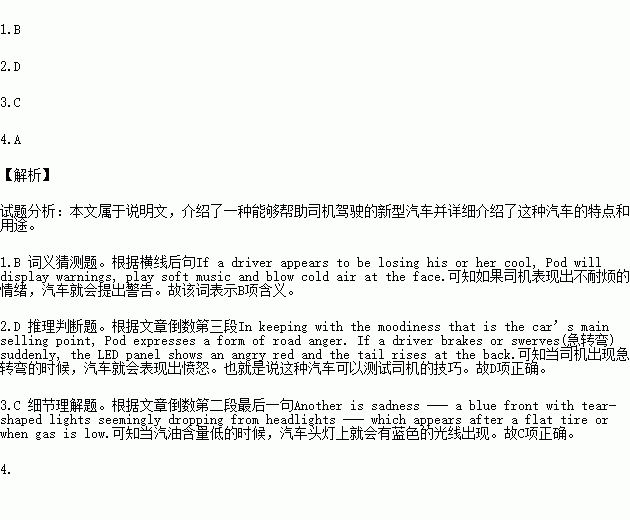题目内容
A new concept vehicle, Pod was introduced by Toyota and Sony at the Tokyo motor show. The car is intended as a four-wheeled friend. It aims to provide affection, sympathy and encouragement. Like a dog welcoming its master, the car sits up, wags its tail and acknowledges its owner’s presence using hydraulics(液压装置) and a multi-coloured LED display panel(引擎) across the front.
While on the road, the car constantly monitors the driver’s mood with pulse and sweat(汗) sensors on the joystick(操纵杆). Cameras focused on the eyes keep watch for any sigh of drowsiness. If a driver appears to be losing his or her cool, Pod will display warnings, play soft music and blow cold air at the face. Drivers are shaken awake with loud music and a shaking chair.
To improve driving skills, Pod uses a comparison to score drivers, offer advice and rank all Pod owners. Toyota claims that the car will eventually be able to learn its owner’s likes and dislikes by monitoring passenger conversations. If the car hears a favorite song being discussed, it will download the track from the Internet and play it without being asked. It will also recommend(推荐) restaurants that might suit the driver’s taste and take photographs of passengers when they sound particularly happy.
In keeping with the moodiness that is the car’s main selling point, Pod expresses a form of road anger. If a driver brakes or swerves(急转弯) suddenly, the LED panel shows an angry red and the tail rises at the back.
Anger is one of the car’s ten “emotional states”. Another is sadness --- a blue front with tear-shaped lights seemingly dropping from headlights --- which appears after a flat tire or when gas is low.
“We wanted to show that the cars can be cheerful and entertaining,” said Yasunori Sakamoto, part of the Toyota design team. Mr Sakamoto said Toyota has no plans to put Pod on the market. Sad, really.
1.The underlined word “drowsiness” in Paragraph 2 means _________.
A. fear B. boredom C. excitement D. sleepiness
2.According to the text, Pod can ___________.
A. rank the restaurant nearby
B. recommend a song to passenger
C. have a conversation with drivers
D. test the driver’s driving skills
3.If the new concept vehicle is running out of gas, __________.
A. the LED panel turns red
B. the tail rises at the back of the car
C. the front light turn blue and look like tears
D.the car stops and shake with loud music
4.What is the author’s attitude towards Pod?
A. Supportive. B. Doubtful.
C. Pessimistic. D. Tolerant.

